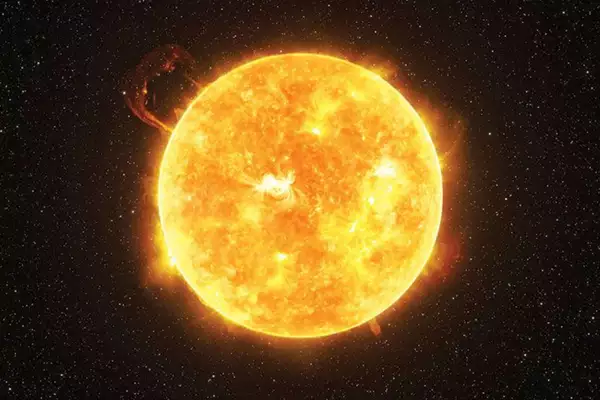Astronomers have successfully mapped the differential rotation of the Sun’s Chromosphere using 100 years of data from the Kodaikanal Solar Observatory.
- This marks the first detailed study of how the Sun’s rotation varies from its equator to its polar regions, providing new insights into the Sun’s inner workings.
Differential Rotation of the Sun
- Definition: Refers to the difference in the Sun’s rotational speed at various latitudes.
- Equator vs. Poles: The Sun’s equator rotates faster (completing one rotation in about 25 days) than its poles, which take approximately 35 days.
- Reason: The Sun is made of plasma, allowing different parts to rotate at different speeds, unlike solid planets like Earth.
Importance of Differential Rotation
- Plays a critical role in-
- The solar dynamo.
- The 11-year solar cycle.
- Periods of intense solar activity.
- Production of magnetic storms that can affect Earth’s space environment.
Impact of Differential Rotation on the Sun
- Magnetic Field: Over time, differential rotation twists and tangles the Sun’s magnetic field.
- Active Regions: Localized strong magnetic fields form active regions where sunspots appear.
- Sunspots: Darker, cooler areas on the Sun’s surface, indicating intense magnetic activity.
- These sunspots are associated with solar storms, such as:
- Solar flares: Intense bursts of radiation.
- Coronal Mass Ejections (CMEs): Expulsions of large volumes of plasma and magnetic fields from the Sun’s corona.
About Kodaikanal Solar Observatory
- Location: Situated in Tamil Nadu, India.
- Operational Since: Celebrating its 125th anniversary.
- Unique Features:
- One of only two places in the world with a century–long daily record of solar data.
- Selected for its proximity to the equator and dust-free, high-altitude environment, ideal for solar observation.
Key Findings from the Study
- Rotation Mapping:
- The study mapped the Sun’s differential rotation from the equator to the poles.
- Faster rotation at the equator (13.98 degrees per day) and slower at the poles (10.5 degrees per day at 80 degrees latitude).
- Both plages and network features showed similar rotation rates, suggesting a common origin within the Sun.
- Plages and Networks:
- Plages are bright areas in the chromosphere with weaker magnetic fields, significantly larger than sunspots.
- Network cells are convective structures with weaker magnetic fields, continuously present across the Sun’s surface, even at the poles.
Significance of the Study
- First-time Success: This study is the first to utilize chromospheric network cells to map solar rotation comprehensively from equator to pole.
- Contribution to Solar Physics:
- Enhances understanding of the Sun’s magnetic field and solar activity.
- Paves the way for more complete models of the Sun’s interior dynamics.
Ref: Source
| UPSC IAS Preparation Resources | |
| Current Affairs Analysis | Topperspedia |
| GS Shots | Simply Explained |
| Daily Flash Cards | Daily Quiz |
Frequently Asked Question:
What is the differential rotation of the Sun?
The Sun’s differential rotation refers to the varying rotational speeds between the equator and the poles.
How fast does the Sun rotate at its equator and poles?
The Sun’s equator completes a rotation in about 25 days, while the poles take roughly 35 days.
What role does the differential rotation play in solar activity?
It influences the solar dynamo, 11-year solar cycle, and the production of magnetic storms.
What is the significance of the Kodaikanal Solar Observatory in this study?
The observatory provided a century’s worth of data to map the Sun’s differential rotation.
What are plages in the Sun’s chromosphere?
Plages are bright, magnetically weaker areas in the chromosphere, larger than sunspots.




